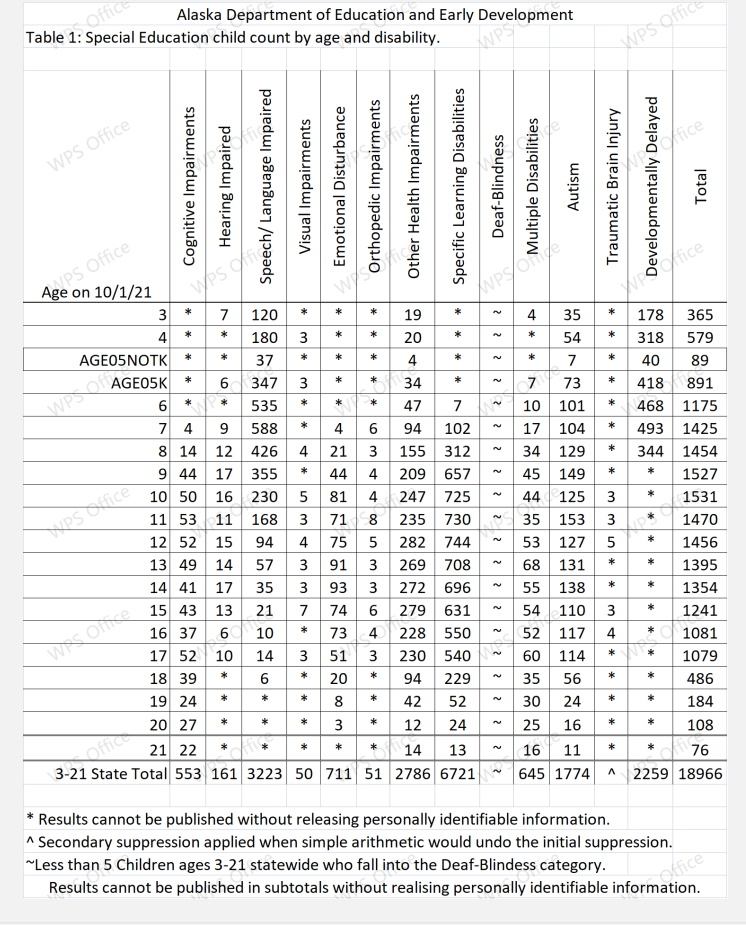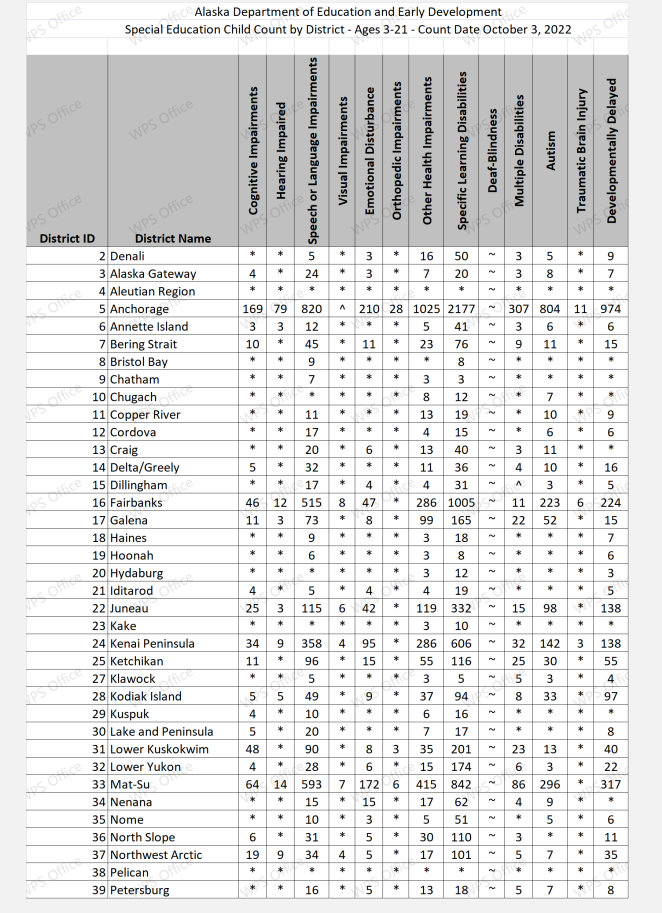And, how ONE Spec Ed Bully can menace a learning
community
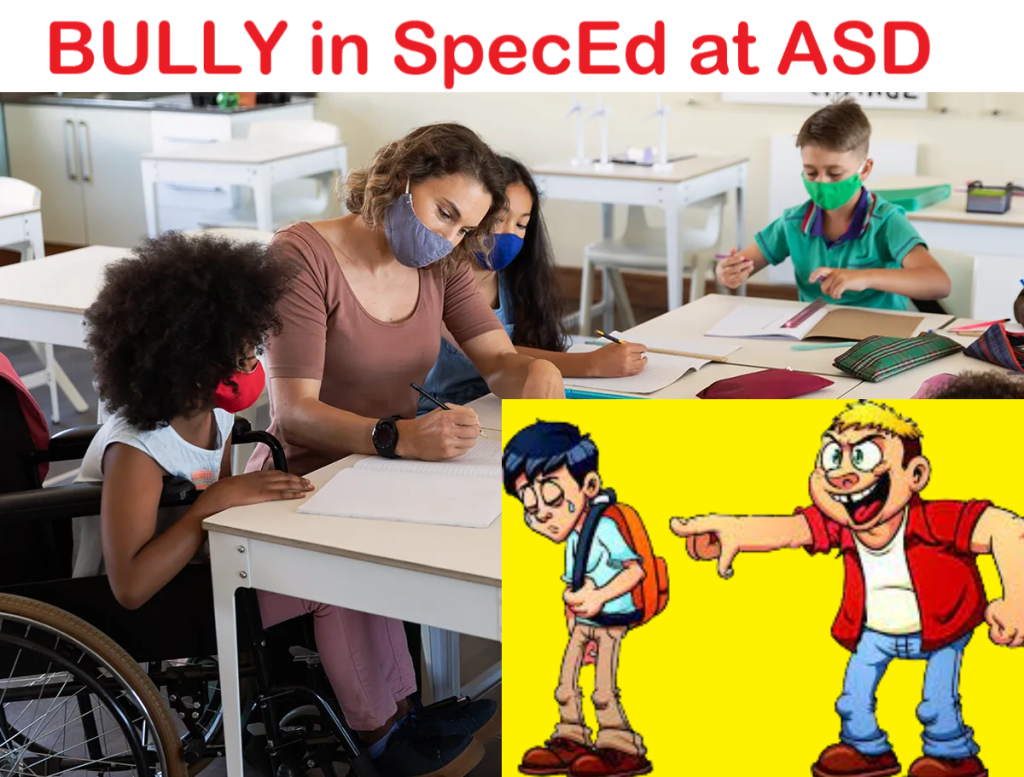
Alaska Public Education is in crisis. Management cannot protect teachers and as more parents abandon the Education Factory Model students at the lower economic strata of society will suffer. This is because government education in Alaska is little more than a money pit for distribution of wealth using children as hostages.
The Anchorage School District (ASD) is one of the few that contributes to cost of education by taxing landowners, and it ain’t cheap.
Nobody Cares About Academic Outcomes
Parents who did well in government schools are able to provide the support structure necessary for their children to likely do well in government schools, too, but children of parents who did not graduate with a traditional diploma are likely to not graduate either. This writer witnessed this phenomenon as a certified teacher who gravitated to Adult Basic Education for this very reason: Parents who have to get a GED are likely to be much more insistent that their own kids buckle down in school.
[1]GED for ALL!
Since I was deeply involved in Alaska’s Public Education goat-rope for many years in Juneau, before I trained as a teacher, I am going to set the stage for this story by providing information many probably don’t know. If more Alaskans understood The Government School Hustle they might insist on reforms before the system breaks down to the point that not only do the students learn little, but teachers are assaulted with impunity.
[2]Alaska State Funding for Government Education according to Department of Education.
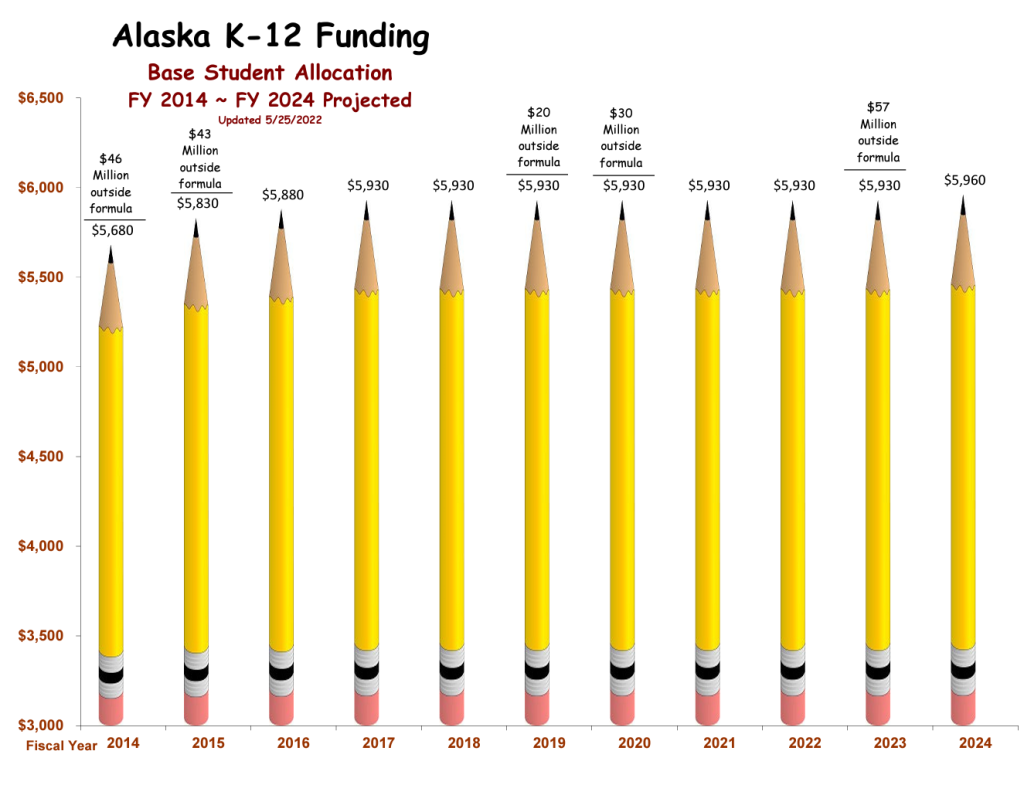
There is no honest justification for raising funding levels for Alaska Government schools except to appease the voracious appetite of the teacher/administrator/support staff unions.
How State Funding Works
Student enrollment by district is called Average Daily Membership (ADM). The numbers of Alaska students have remained stable at around 128,000 per year since FY2014. The hustle of educrats has always been to try to get the Alaska Legislature to increase payment for ADM–not to insist that more districts pay an equity share of their local education costs or that schools be accountable for academic outcomes.
[3]Average Daily Membership by District 2014-2023
Based on the ADM, each of the 48 identified Alaska School Districts receives support from State and Federal sources. In FY2023 that total amount was $1,213,730,495.
[4]FY2023 Amount paid for government schools by district
One really laughable category of funding is the Quality Schools Grant. This hustle was started in 1998 to increase student achievement through methodical improvement of Alaska’s public schools.
No Standards, No Proof of Results, No Accountability
Our bovine legislature stand each legislative session still while utters are squeezed for a Quality Schools payoff: $4,137,084 in FY2023.
[5]Quality Schools Hustle
The National Center for Education Statistics (NCES) is the primary statistical agency of the U.S. Department of Education. The National Assessment of Educational Proficiency (NAEP) provides information about student learning and achievement as The Nation’s Report Card. NAEP has published information annually describing the academic caliber of our Alaska schools after decades of throwing money at the Quality School Hustle.
[6]2022NAEP State Report Cards
But the data for NAEP Reports comes from each State Department of Education, and after the Covid Pandemic many other states have had great declines in their academic outcomes due to unnecessary mandates. Alaska has engage a new testing regimen, so expect great news to be announced by doing nothing but changing the testing instrument. The educrats think parents are stupid but want their kids to be smart.
[7]Alaska Department of Education Testing Results
The New Alaska System of Academic Readiness
Thus, the whole Alaska Government Education House of Cards revolves around getting State funding from the legislature by activating vested interests into begging, pleading or throwing fits. This is facilitated by teacher unions who buy legislators and even governors.
Educrats arrive at individual district funding amounts with this formula of add-ons to the base funding amount, including the Special Ed Bonus:
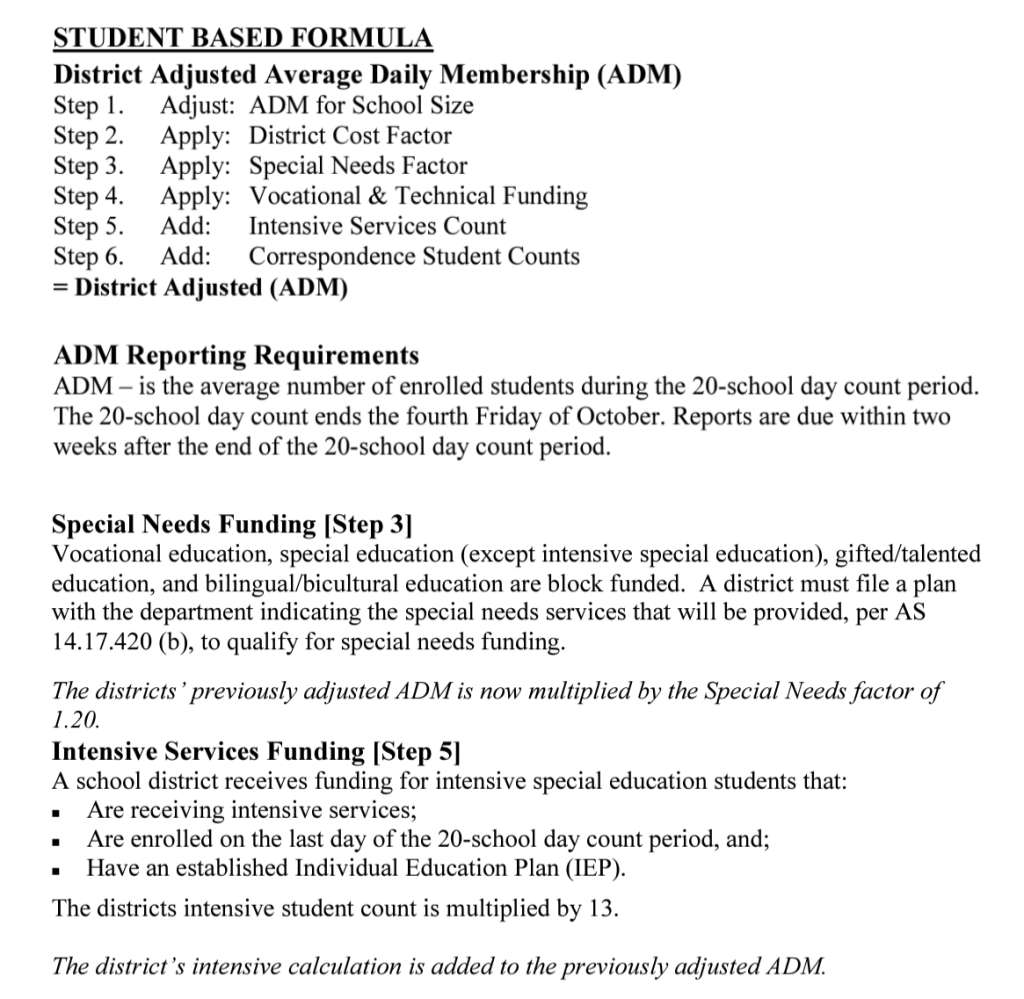
https://education.alaska.gov/SchoolFinance/pdf/Funding-Overview.pdf
Amount Paid to a District under this formula for ONE special Needs Student is the Equivalent of the amount paid for THIRTEEN non-SpecEd students! That means a good SpecEd Teacher can contribute big bucks to a school district like ASD.
As a teacher in a rural district this writer remembers well the superintendent admonishing teachers to tell parents to make sure their kids were in attendance on the announced student count day even if they had to be brought in on a gurney. No such urgancy was expressed on the Statewide Assessment Testing Days, when low numbers of students testing in most districts show the disregard Alaska Educators have for proving they are doing their jobs.
Tests of Students Measure their Teachers, You Know
Academic outcomes don’t matter. Results from previous Peaks Statewide Assessments were embarrassing and Covid provided a new reason to change vendors for the tests. But you can bet that if assessment outcomes were tied to funding our educrats would be doing something besides going to Juneau every legislative session with tin cups.
[8]2020-21 Peaks Press Release from DOE Commissioner Michael Johnson
Funding to keep doing what isn’t working is all that matters. And since many of our elected officials are owned by the teacher unions this is never going to change. Up to 50 locally-elected School Boards join the cartel of Administrator Associations and Unions to threaten and intimidate any elected official in Juneau who doesn’t go along with their mob demands for ever more funding of sub-par government schools.
Parents don’t matter in this scam. The PTA is an arm of NEA-Alaska. Whenever the voracious appetite of these organizations is not fed, they go to Alaska Courts who always pay the ransom. We have the distinction of being the state where we can PROVE throwing money at education does not improve the quality of the schools or academic outcomes of students.
[9]Court Decisions
Government Schools’ Soft Underbelly: $pecEd
Of all the sacred cows in government education, Special Education gives the most milk.
[10]What is Special Education?
Under the federal Individuals with Disability Act (IDEA) the State of Alaska receives federal money to support programs for students who qualify as having identified Special Needs. Nearly every Alaska district has SpecEd students who qualify the district for extra federal/state funding. For instance, of 43,086 students enrolled in the Anchorage School District in 2021-22 exactly 6405 students with disabilities provided extra funding for their educational needs, 382 of whom were aged 3-5 and not even in kindergarten! Some others were as old as 21!
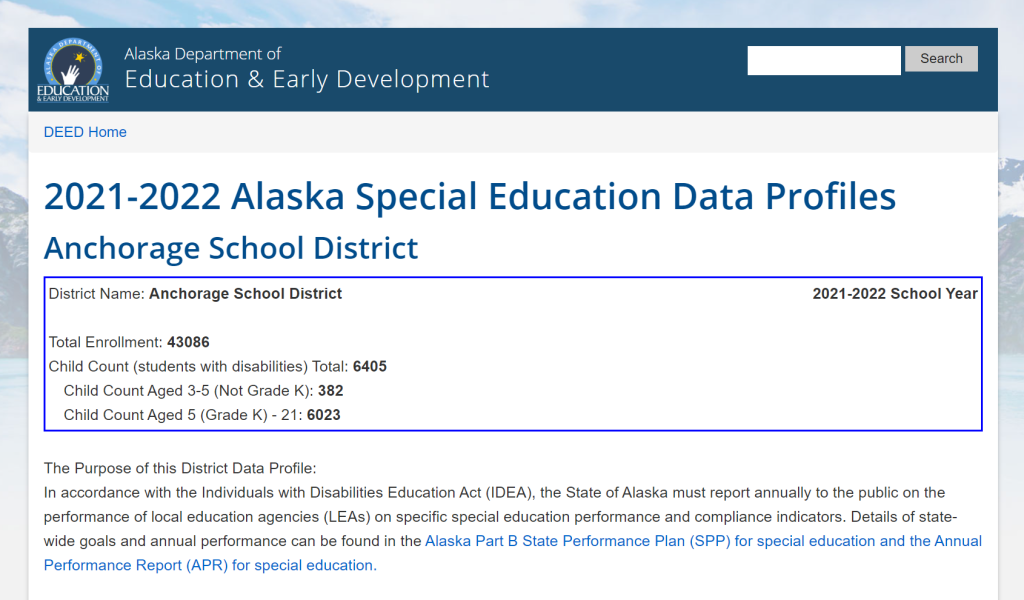
[11]ASD 2021-2022 AK Special Ed Data Profiles
It’s therefore easy to see why a system driven solely by economic opportunity places an emphasis on SpecEd over promotion of academic excellence such as might be found by encouraging Honors or AP Programs.
[12]Honors vs. AP Classes: What’s the Difference?
As a substitute teacher in Juneau and Anchorage over a few years as this writer was proving up on requirements for certification, I worked in some SpecEd classes. It takes a special kind of teacher to work with students having Special Needs and I didn’t fit that profile, but I recognized the qualities of patience and consistency required to help those students realize their potential. Later I was successful in helping a number of persons previously identified as having Special Needs (with IEPs) to earn their GED.
Some Events Should Never Happen in our Schools
I will call this teacher Terri.
This is my first year as a solo middle school teacher lacking only the Praxis Test to be certified after finishing my Master’s Degree in teaching. I have been substitute teaching in ASD a few years now and this year and I have four Special Education students–primarily having Autism Spectrum Disorders with other identified disabilities. Two are verbal and two are not, explained Terri. My specialty is Social Studies and I am transitioning to Special Needs Education.
The previous principal asked me if I would consider SpecEd. We have a new principal.
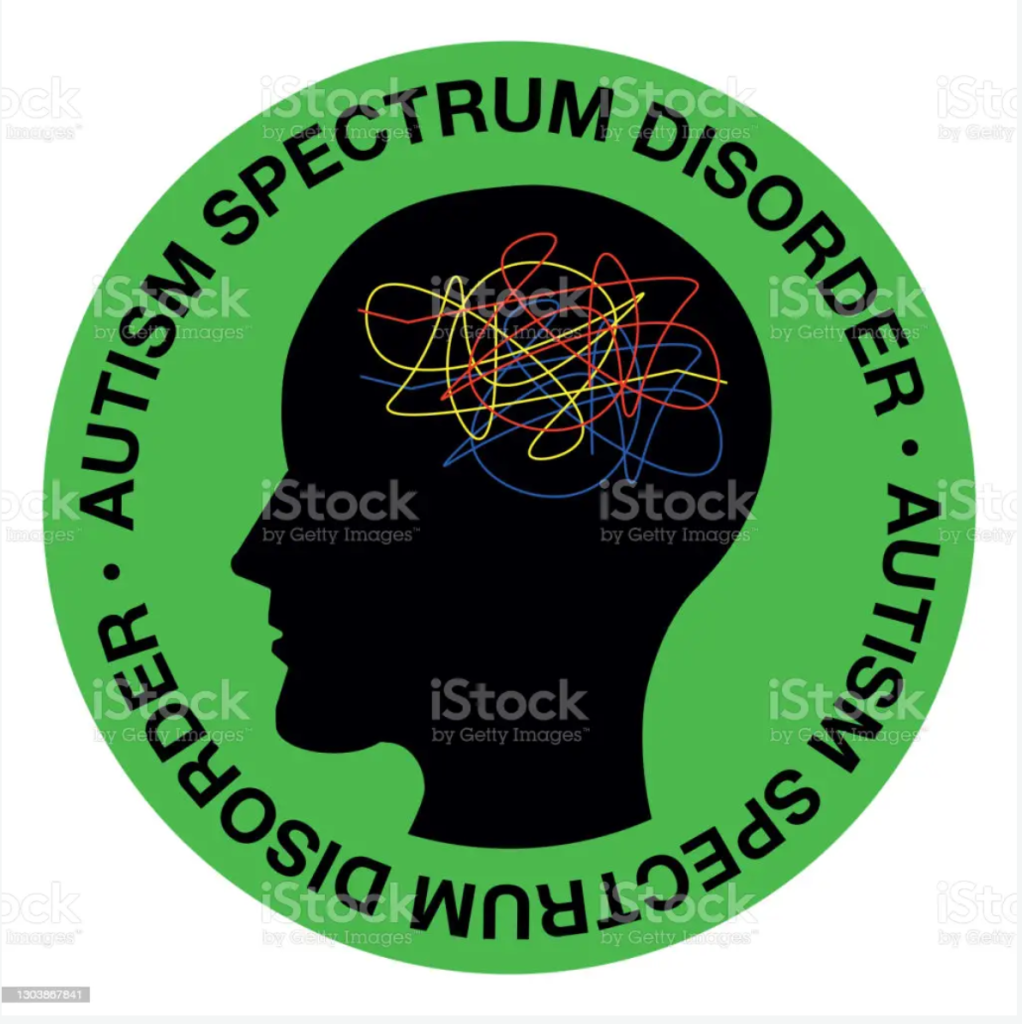
Autism spectrum disorder is a condition related to brain development that impacts how a person perceives and socializes with others, causing problems in social interaction and communication. The disorder also includes limited and repetitive patterns of behavior. The term “spectrum” in autism spectrum disorder refers to the wide range of symptoms and severity.
https://www.mayoclinic.org/diseases-conditions/autism-spectrum-disorder/symptoms-causes/syc-20352928
Q: What kind of things have you learned as a sped teacher since you’ve been in that role?
A: There is quite a bit of communication that has to be developed with these students to begin to understand what their needs are–to really meet those needs. There has to be a relationship built on trust, and the student must be comfortable with the teacher. So that’s probably the most important ingredient that I have learned from teaching solo–to be able to relate to the student to teach them.
Q: As autistic students, do they really understand what’s going on, or are they just kind of along for the ride?
A: They do understand that they’re in a different environment. And I think they do understand that there’s a different expectation from them at school than there is at home, continued Terri. They all need one-on-one (teacher-directed) instruction. I am in this job because I seem to be able to understand the students and be able to help them learn. That’s a huge part of how I ended up being in this setting.
Q: So parents bring their precious children to ASD–having Special Needs–and each has an Individualized Education Plan (IEP)–where parents get to meet regularly with teacher and team overseeing their children’s needs?
A: Yes, and I have a Teacher Aide (TA).
Q: So tell me what has happened in this setting that is causing you problems.
A: At the beginning of the year I had a fifth student who is highly functional. Academically he is in a place where the other autistic students had not reached or probably even have the potential to reach. It was kind of a unique situation that he was in my classes in the first place. Then I learned that he was put in my class because of his behavior! It was hoped that if he were in a different surrounding his behavior would improve.
His behavior last year was very aggressive; he would poke people with his pencil and hit people. I was subbing so I didn’t spend a lot of time there, but other teachers and TAs were trying to deal with him and weren’t very successful. So this year some events caused them to call in what’s called the B Team–behavior specialists–who were going to evaluate him for eight weeks, and then give an assessment whether he should be moved or not moved from my class.
He starts out, you know, pretty mellow. Then within the first weeks, he is showing signs of aggression. He may have some autism but he’s very intelligent. He can read and he can write and has beautiful handwriting. So he’s already standing out because he, as I learned later, shouldn’t have been in that class anyway.
At any rate, he begins his year hitting and poking and throwing. And then I noticed that he would find a student to target. At one point, he was targeting a young girl. Pretty much every other day he was throwing milk cartons or applesauce cups–hitting her, kicking her, making her cry. He targeted another two young boys that were in class–a girl and two boys. He would kick and hit one of the autistic boys and cause a meltdown. This would go on for hours. We would have to call home and tell the parents to pick him up.
Q: This is classic Bully Behavior. A more seasoned teacher might have put their foot down to management and insisted that this kid be removed from this class. What did you do?
A: I asked for help. I needed my questions to be answered, like: Why is this boy in my class? The B Team was supposed to evaluate this student and the eight weeks have come and gone but the behavior continues. They came in at the beginning of the school year and now the year is almost over. Just today April 10 he threw an apple and hit a girl in the face!
What are the Rights of Special Ed Students who are Bullied?
At one point all of the kids were in the recreation room and this student kept aggressively throwing the ball at the face of the girl who is his primary target. The other students then formed a ring around the girl to protect her! She is learning to be passive, to be a victim, and he is learning there are no consequences for his behavior.
In fact, on another occasion the girl came into my classroom seeking protection! I am not her teacher but she is coming to me. He has now been suspended a few times but staff are taught to ignore the bully. How can this be okay?
When I confronted him on one occasion he sexually assaulted ME! He also did it to another paraprofessional with no consequences!
Q: Did you call 911? The question I have is why isn’t this predator in Whaley School or McLaughlin Youth Center?
A: I pressed charges. But maybe a month ago while holding the door open for him to pass he elbowed me in the mouth. I was bleeding but again NO CONSEQUENCES!
Q: Doesn’t your principal try to do anything?
A: As I understand, the principal no longer has any say because the B Team is supposed to have taken over. They drop in every day in the morning and nothing happens. ASD is programming this student to be a failure. I have reached out to some other organizations concerned about Alaska’s high incidence of bully behavior and I have reached out to you through a previous Alaska Legislator who suggested that you might be interested in this story.
ASD receives the equivalent funding of 52 students for these four Special Needs students under the Alaska Foundation Funding formula.
Thank you Terri for having the courage to stand up for your students to a bully. You are a valuable asset to the Community of Anchorage and ASD.
If you like this story please consider making a free-will contribution and forward it to others.
DONN
References:
[1]GED for ALL!
[2]State Funding for Government Education is provided under a complicated Foundation Funding Formula that guaranties no Alaskan with a high school diploma is likely to understand what was paid for what they got.
https://education.alaska.gov/schoolfinance/foundationfunding
The current state public school funding formula was adopted under Senate Bill 36 in 1998 and implemented in 1999. The public school funding formula is defined in Alaska Statute 14.17, State Aid to Public Schools.
[3]Average Daily Membership by District 2014-2023.
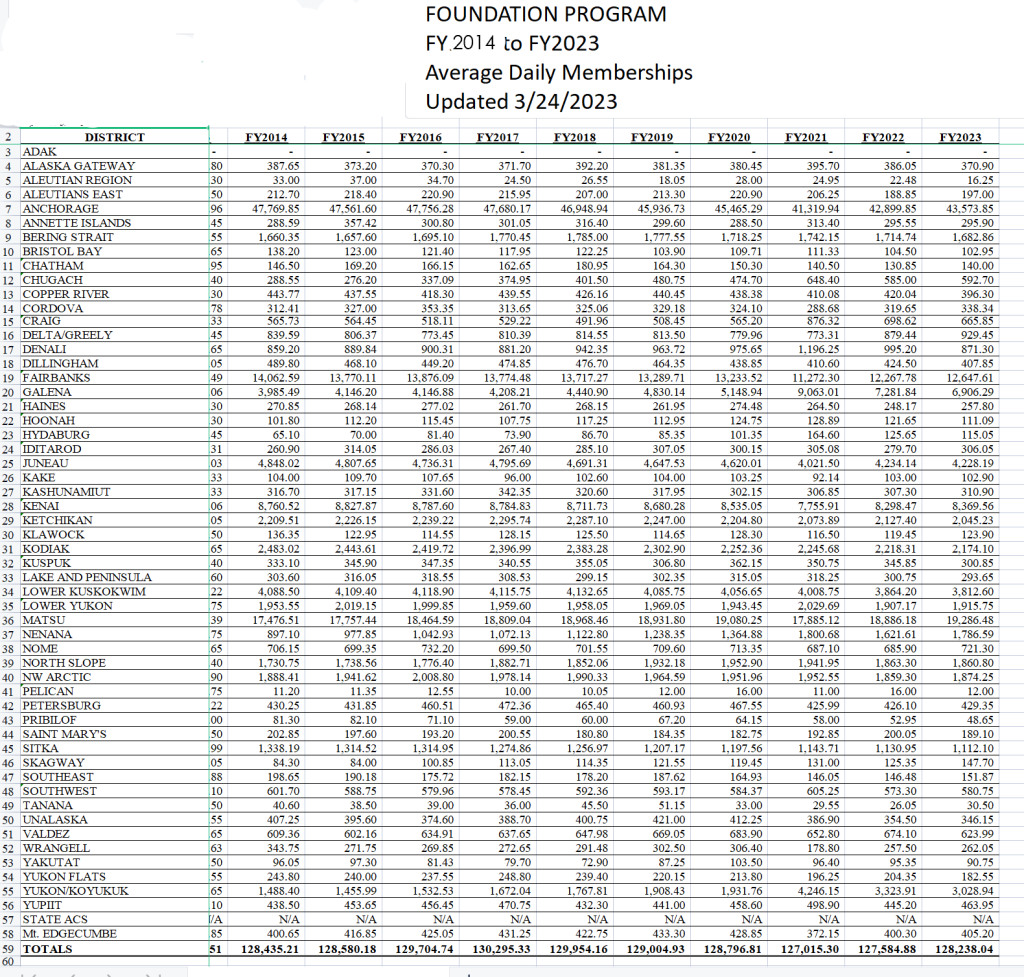
[4]FY2023 Amount paid for government schools by district
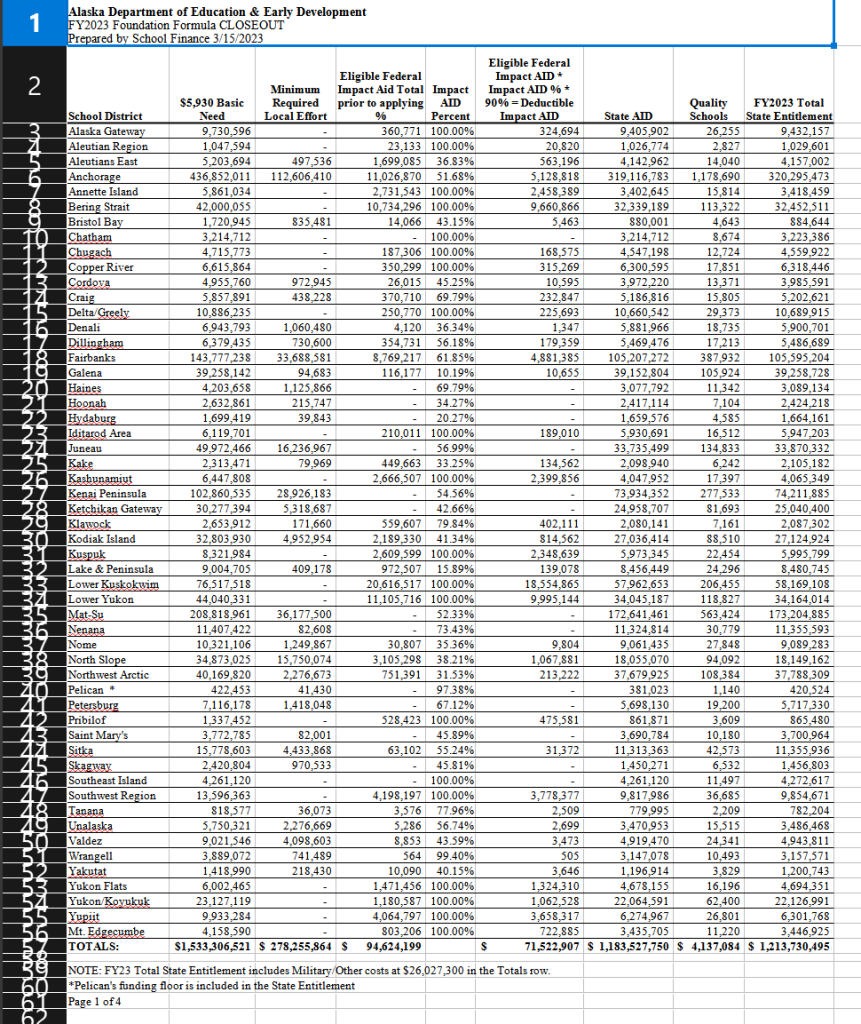
[5]Quality Schools Hustle
https://education.alaska.gov/quality-schools
Quality Schools
The Quality Schools Grant Program began in 1998. This purpose of this grant program is to increase student achievement through the methodical improvement of Alaska’s public schools. The Quality Schools Initiative promotes this school improvement by providing clear standards for schools to attain.
The standards fall into the following categories:
- Student Standards: English Language Arts, Math, Science, Arts, Digital Literacy, Employability, History, Computer Science, Library/Information Literacy, Skills for a Healthy Life, Cultural, Geography, World Languages, Government and Citizenship, and Physical Education;
- Professional: Educator Content and Performance Standards;
- Family, School, Business, and Community Networks; and
- School Excellence Standards
Please refer to DEED’s Standards website for specific information. Professional, Family, and School Excellence Standards can be found under “Other Standards”. Quality School funds must be spent advancing one or more of these categories.
Approximately 4 million dollars is allocated (district entitlements are calculated by multiplying by $16 the district’s adjusted ADM) to Alaska School Districts each year through the Quality Schools Initiative. Districts must dedicate their Quality School Grant funds to efforts that clearly fall under one of the established grant goals above, and be able to demonstrate how their funded activities contribute to student academic achievement.
2022 NAEP Alaska School Report Cards
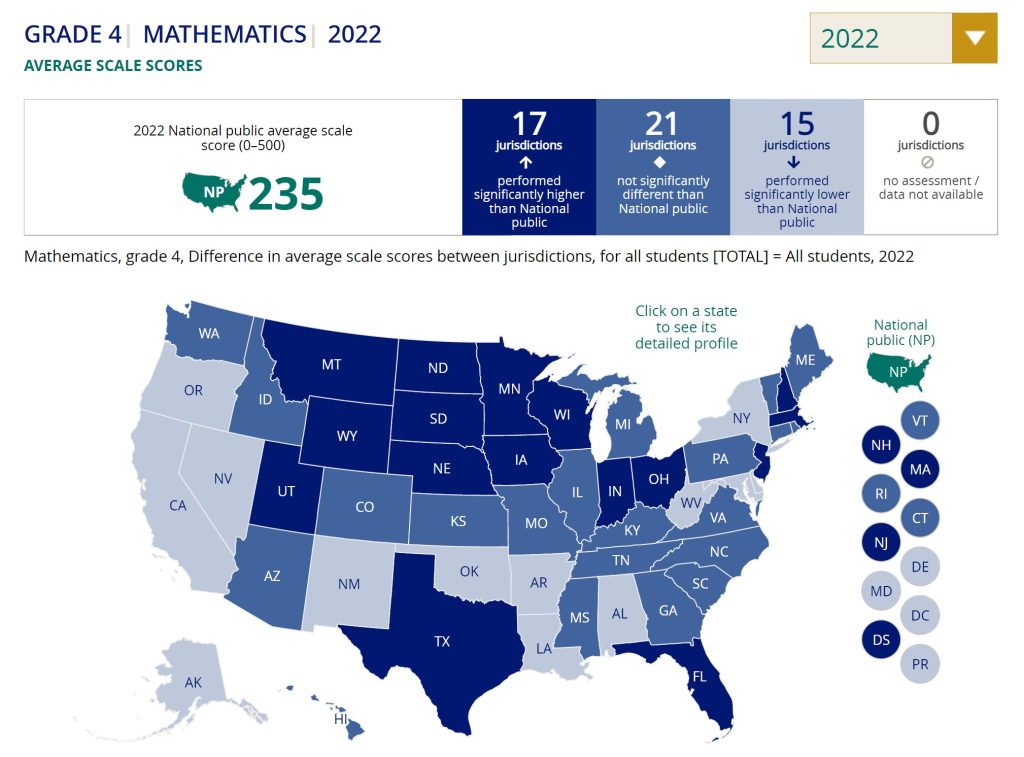
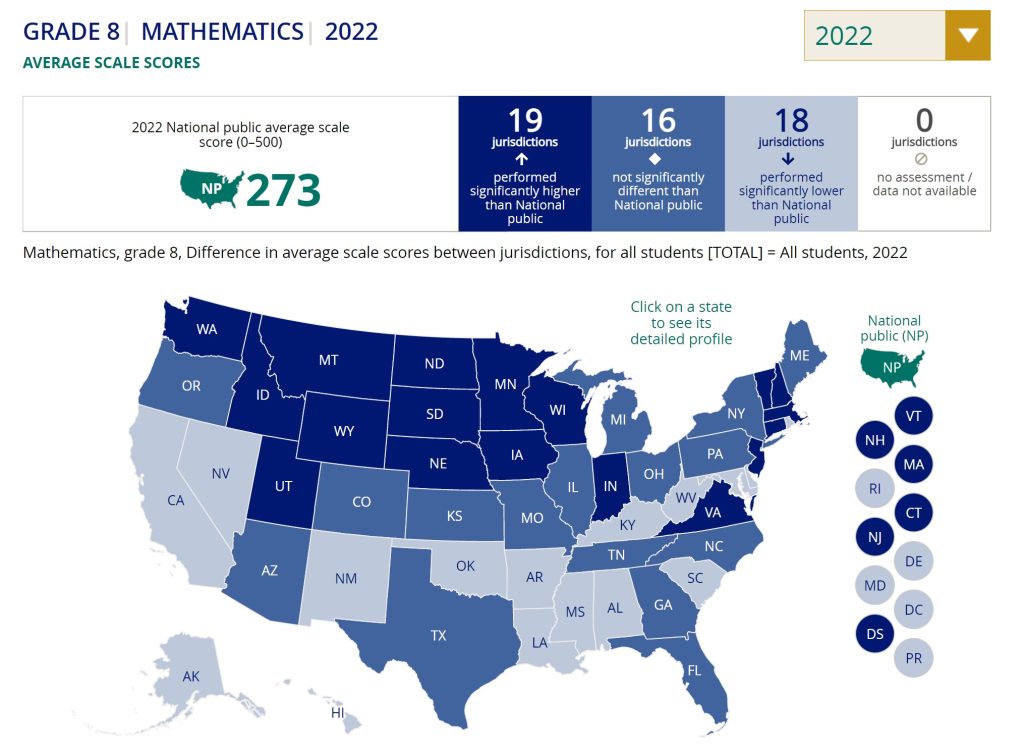
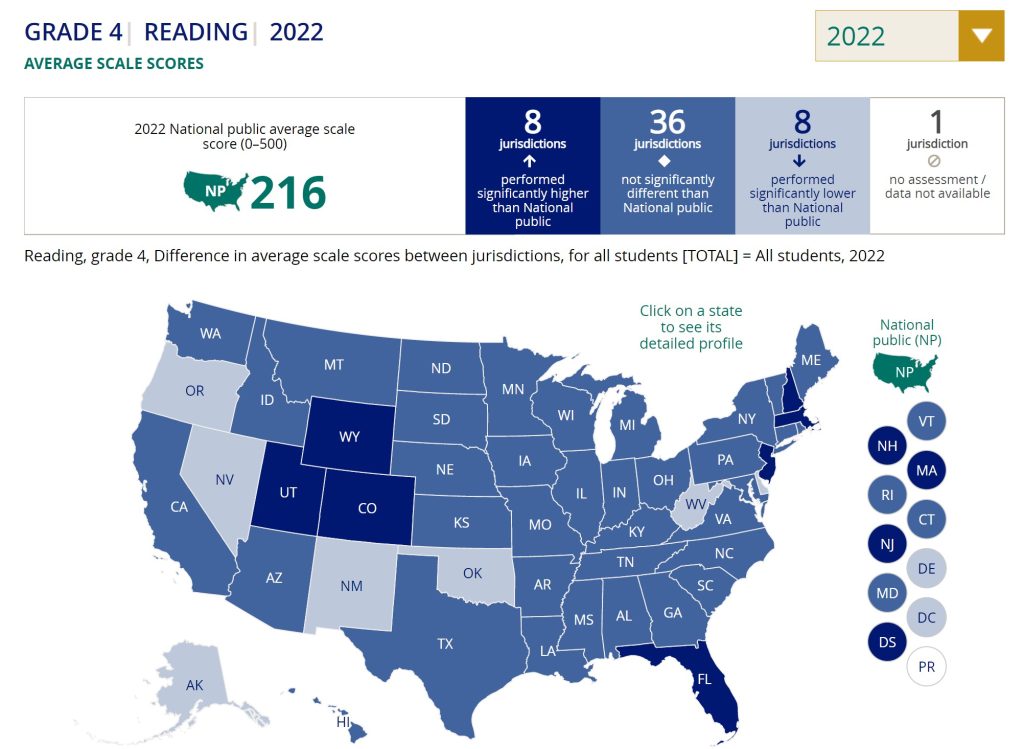
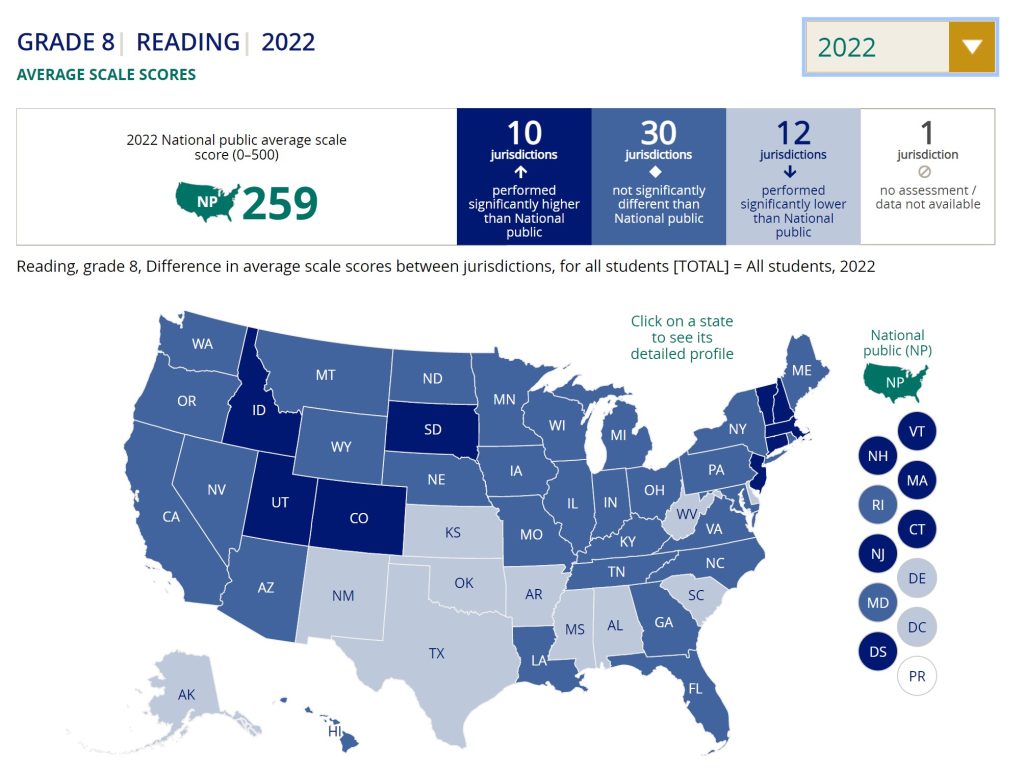
[7]Alaska Department of Education Testing Results
The New Alaska System of Academic Readiness
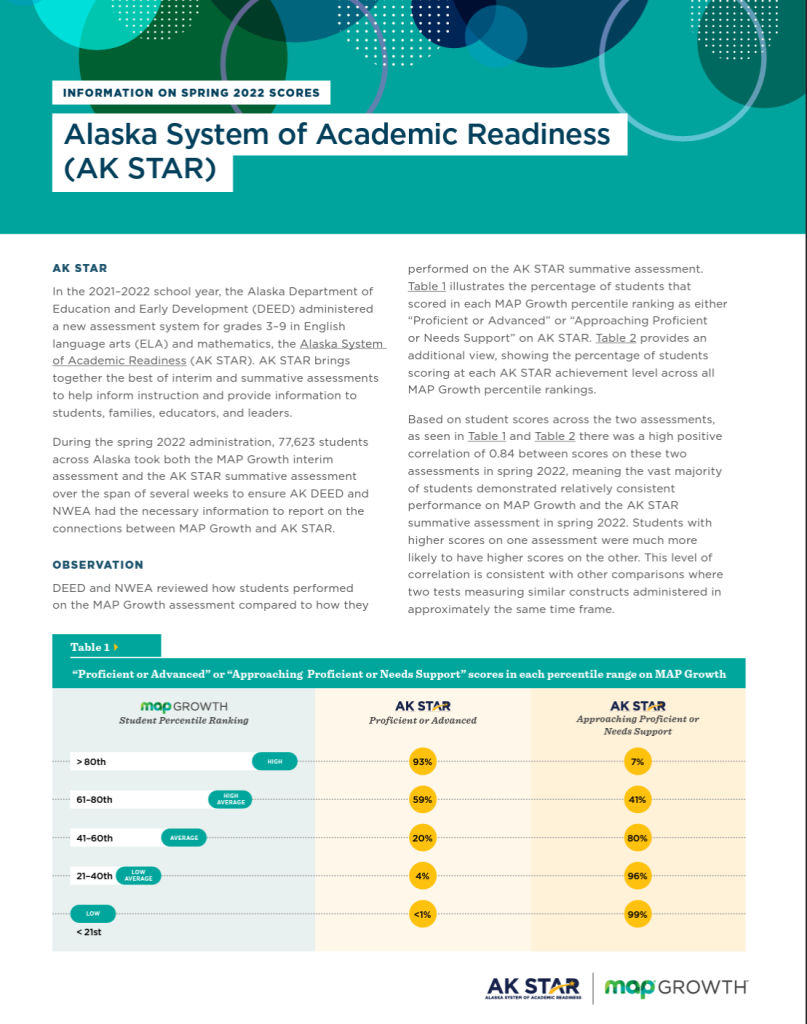
[8]Peaks Press Release
https://education.alaska.gov/news/releases/2021/9.7.21%20DEED%20releases%202021%20PEAKS%20assessment%20results.pdf
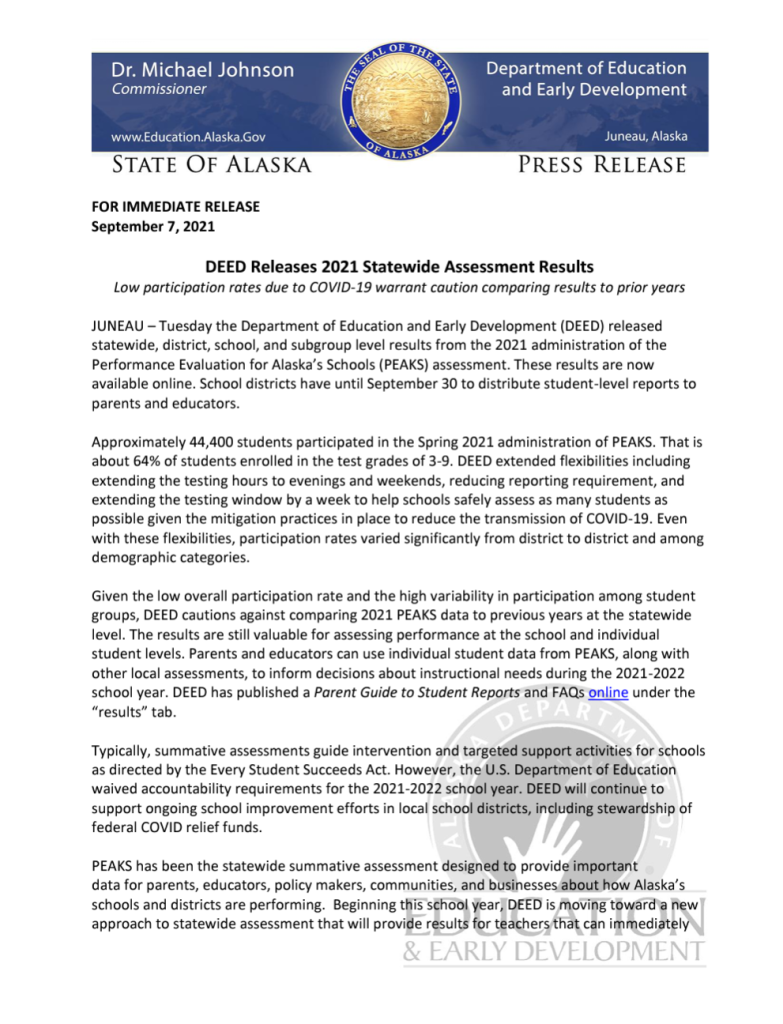

[9]Court Decisions
Hootch v. Alaska State-Operated School System, 536 P.2d 793, 1975
Tobeluk v. Lind, 589 P.2d 873, 1979
Kasayulie v. State, Superior Court Case no. 3AN-97-3782 Civil, 1997
Moore v. State, Case No. 3AN-04- 9756 CI, 2012
Ten Eyck v. State, Superior Court Case no. 4FA93-2135 Civil, 1993
[10]What is Special Education?
Special education refers to a range of services that help kids with disabilities learn. It’s not a “one size fits all” approach — special education is tailored to meet the needs of individual kids. Kids who qualify for special education have an IEP.
https://www.understood.org/en/articles/understanding-special-education
[11]ASD 2021-2022 AK Special Ed Data Profiles
[12]Honors vs. AP Classes: What’s the Difference?
https://education.alaska.gov/data-center
